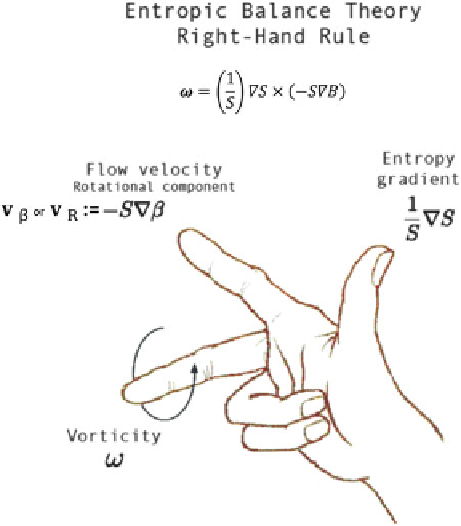Geoscience Reference
In-Depth Information
Fig. 18.1 Entropic right
hand rule.
The rule shows
the mutually orthogonal
vector relation, similar to the
so-called Fleming's right
hand rule of electro-magnetic
fields, now we may call as
“entropic right hand rule”,
among the orthogonal
variables of spatial three
dimensions, entropy gradient
(1/S)
S, rotational
component of flow velocity
v
R
or
v
ˇ
WD S
r ˇ
and
vorticity
!
r
the rotational flow velocity component,
S
rˇ
, denoted by
v
ˇ
or
v
R
, while the
divergent component,
r˛
, denoted
v
˛
or
v
D
. These notations are used in the figure
illustrations of this article. Figure
18.1
illustrates schematically the entropic right-
hand rule.
18.3
Entropic Balance Equation Viewed from Completeness
of Solution
Because of the variational principle used in the entropic balance theory, the diagnos-
tic (
18.5
) should be satisfied always with all other prognostic E-L equations. In the
schematic diagram of the solution space (Fig.
18.2
), it is shown that the solution sub-
space DS is expressed as a part of the other solution subspaces, NSS (non-stationary
state) and SS (stationary state). Since the helicity becomes nearly maximum at
the time of mesocyclone development and tornadogenesis, as will be discussed in
Sect.
18.4
(i.e., the local change of vorticity vanishes as will be seen from (
18.12
)),
the long-lasting subspaces, DS (diagnostic state) and SS, are essential.
The solution in the sub-domain covered by DS and SS has a long-lasting property
that is similar mathematically to the attractor in nonlinear dynamics. They appear in
Fig.
18.2
as the sub-domains of the solution space, DS and SS. Note that
DS SS NSS
:
(18.7)

Search WWH ::

Custom Search